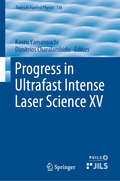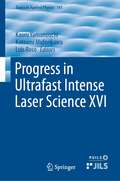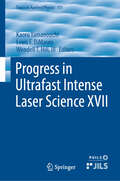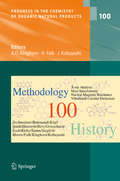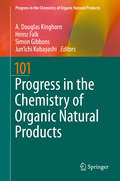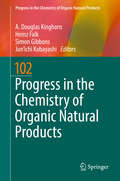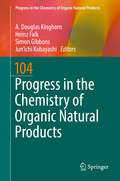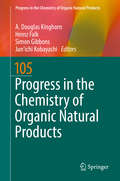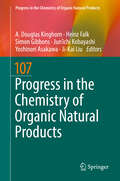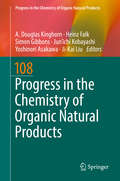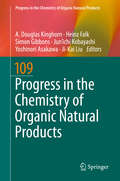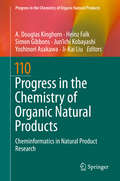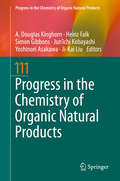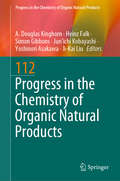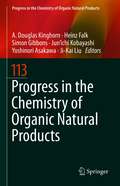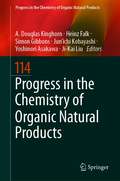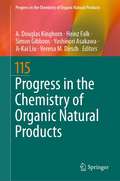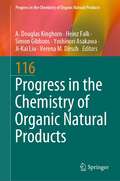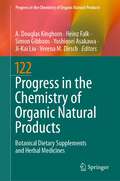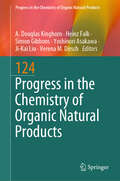- Table View
- List View
Progress in Ultrafast Intense Laser Science XV (Topics in Applied Physics #136)
by Kaoru Yamanouchi Dimitrios CharalambidisThis book covers a diverse cross section of this interdisciplinary research field, with contributions grouped into four categories: laser-induced filamentation; atoms and molecules in a laser field; interaction of solid materials with a coherent light field; and ion acceleration and ionization of atoms in super intense laser fields.This book series presents up-to-date reviews of advances in this interdisciplinary research field, spanning atomic and molecular physics, as well as molecular and optical science, which have been stimulated by the recent developments in ultrafast laser technologies. Each book compiles peer-reviewed articles by researchers at the forefront of their particular subfields. All the chapters include an overview to allow graduate students and researchers unfamiliar with the subfield to grasp the importance and attractions of the topic covered, followed by reports of cutting-edge discoveries.
Progress in Ultrafast Intense Laser Science XVI (Topics in Applied Physics #141)
by Kaoru Yamanouchi Luis Roso Katsumi MidorikawaThis book covers a broad range of topics from the interdisciplinary research field of ultrafast intense laser science, focusing on atoms and molecules interacting with intense laser fields, laser-induced filamentation, high-order harmonics generation, and high power lasers and their applications. This sixteenth volume features contributions from world-renowned researchers, introducing the latest reports on probing molecular chirality with intense laser fields, and the most recent developments in the Shanghai Superintense Ultrafast Laser Facility project.The PUILS series delivers up-to-date reviews of progress in this emerging interdisciplinary research field, spanning atomic and molecular physics, molecular science, and optical science, which has been stimulated by the recent developments in ultrafast laser technologies. Each volume compiles peer-reviewed articles authored by researchers at the forefront of each of their own subfields of ultrafast intense laser science. Every chapter opens with an overview of the topics to be discussed, so that researchers unfamiliar to the subfield, especially graduate students, can grasp the importance and attractions of the research topic at hand; these are followed by reports of cutting-edge discoveries.
Progress in Ultrafast Intense Laser Science XVII (Topics in Applied Physics #151)
by Kaoru Yamanouchi Wendell T. Hill III Louis F. DiMauroThis book covers a broad range of interdisciplinary topics, focusing on atoms and molecules in intense laser fields, excitation processes in intense laser fields, photonics and materials, high-order harmonics generation, XFEL, high-power lasers and their applications, and quantum computing. This seventeenth volume features contributions from world-renowned researchers on topics such as applications of attosecond and femtosecond laser pulses, coherence and dynamics in quantum systems, and applications of super-intense laser fields.The PUILS series delivers up-to-date reviews of progress in this emerging interdisciplinary research field, spanning atomic and molecular physics, molecular science, and optical science, which has been stimulated by the recent developments in ultrafast laser technologies. Each volume compiles peer-reviewed articles authored by researchers at the forefront of each of their own subfields of ultrafast intense laser science. Every chapter opens with an overview of the topics to be discussed, so that researchers unfamiliar with the subfield, especially graduate students, can grasp the importance and attractions of the research topic at hand; these are followed by reports of cutting-edge discoveries.
Progress in Vehicle Aerodynamics and Thermal Management: 11th Fkfs Conference, Stuttgart, September 26-27 2017
by Jochen WiedemannThe books presents latest information about new car developments, new or improved testing techniques and new or improved calculation procedures. Presenters are from industry and academia.
Progress in Wall Turbulence 2
by Ivan Marusic Javier Jimenez Michel StanislasThis is the proceedings of the ERCOFTAC Workshop on Progress in Wall Turbulence: Understanding and Modelling, that was held in Lille, France from June 18 to 20, 2014. The workshop brought together world specialists of near wall turbulence and stimulated exchanges between them around up-to-date theories, experiments, simulations and numerical models. This book contains a coherent collection of recent results on near wall turbulence including theory, new experiments, DNS and modeling with RANS, LES. The fact that both physical understanding and modeling by different approaches are addressed by the best specialists in a single workshop is original.
Progress in Wall Turbulence: Proceedings of the WALLTURB International Workshop held in Lille, France, April 21-23, 2009
by Ivan Marusic Javier Jimenez Michel StanislasThis book will consist of a coherent collection of recent results on near wall turbulence including theory, new experiments, DNS, and modeling with RANS, LES and Low Order Dynamical Systems.
Progress in the Chemistry of Organic Natural Products 100
by H. Falk J. Kobayashi A. D. KinghornThe volumes of this classic series, now referred to simply as "Zechmeister" after its founder, L. Zechmeister, have appeared under the Springer Imprint ever since the series' inauguration in 1938. It is therefore not really surprising to find out that the list of contributing authors, who were awarded a Nobel Prize, is quite long: Kurt Alder, Derek H. R. Barton, George Wells Beadle, Dorothy Crowfoot-Hodgkin, Otto Diels, Hans von Euler-Chelpin, Paul Karrer, Luis Federico Leloir, Linus Pauling, Vladimir Prelog, with Walter Norman Haworth and Adolf F. J. Butenandt serving as members of the editorial board. The volumes contain contributions on various topics related to the origin, distribution, chemistry, synthesis, biochemistry, function or use of various classes of naturally occurring substances ranging from small molecules to biopolymers. Each contribution is written by a recognized authority in his field and provides a comprehensive and up-to-date review of the topic in question. Addressed to biologists, technologists and chemists alike, the series can be used by the expert as a source of information and literature citations and by the non-expert as a means of orientation in a rapidly developing discipline.
Progress in the Chemistry of Organic Natural Products 101
by A. Douglas Kinghorn Heinz Falk Simon Gibbons Jun'Ichi KobayashiThe volumes of this classic series, now referred to simply as "Zechmeister" after its founder, Laszlo Zechmeister, have appeared under the Springer Imprint ever since the series' inauguration in 1938. The series has featured contributions by seven Nobel laureates: D. H. R. Barton, D. Crowfoot Hodgkin, L. Pauling, K. Alder, O. Diels, P. Karrer, and H. von Euler-Chelpin. The volumes contain contributions on various topics related to the origin, distribution, chemistry, synthesis, biochemistry, function or use of various classes of naturally occurring substances ranging from small molecules to biopolymers. Each contribution is written by a recognized authority in the field and provides a comprehensive and up-to-date review of the topic in question. Addressed to biologists, technologists, and chemists alike, the series can be used by the expert as a source of information and literature citations and by the non-expert as a means of orientation in a rapidly developing discipline.
Progress in the Chemistry of Organic Natural Products 102
by Heinz Falk A. Douglas Douglas Kinghorn Simon Gibbons Jun'Ichi KobayashiThe first contribution reviews the phytochemical, chemical,and biological literature on members of the ingenane class of diterpenoids fromtheir first isolation in 1968 through 2015, highlighting unresolved issues bothcommon to phorboids and specific to ingenol derivatives. The biogenesis of ingenol is discussed in thelight of the Jakupovic proposal of a dissection between the formation of the macrocyclicEuphorbia diterpenoids and the phorboids,and the clinical development of ingenol mebutate is chronicled in the light ofits "reverse-pharmacology" focus. The second contributionoffers a comprehensive view of the chemical wealth and the taxonomic problemscurrently impeding chemical and biological investigations of the genus Laurencia. It addresses the botanical description and the growth andpopulation dynamics of the genus, as well as its chemical diversity and ecologicalrelations; the secondary metabolites as well as their sources of isolation; and finally the biological activity.
Progress in the Chemistry of Organic Natural Products 104 (Progress in the Chemistry of Organic Natural Products #104)
by A. Douglas Kinghorn Heinz Falk Simon Gibbons Jun'Ichi KobayashiThe first contribution describes apolar and polar molecular fossils and, in particular biomarkers, along the lines usually followed in organic chemistry textbooks, and points to their bioprecursors when available. Thus, the apolar compounds are divided in linear and branched alkanes followed by alicyclic compounds and aromatic and heterocyclic molecules, and, in particular, the geoporphyrins. The polar molecular fossils contain as functional groups or constituent units ethers, alcohols, phenols, carbonyl groups, flavonoids, quinones, and acids, or are polymers like kerogen, amber, melanin, proteins, or nucleic acids. The final sections discuss the methodology used and the fundamental processes encountered by the biomolecules described, including diagenesis, catagenesis, and metagenesis. The second contribution covers the distribution of phthalides in nature and the findings in the structural diversity, chemical reactivity, biotransformations, syntheses, and bioactivity of natural and semisynthetic phthalides.
Progress in the Chemistry of Organic Natural Products 105
by A. Douglas Kinghorn Heinz Falk Simon Gibbons Jun'Ichi KobayashiThe first contribution reviews the occurrence of xanthine alkaloids in the plant kingdom and the elucidation of the caffeine biosynthesis pathway, providing details of the N-methyltransferases, belonging to the motif B' methyltransferase family which catalyze three steps in the four step pathway leading from xanthosine to caffeine. The second contribution in this book provides a background on the molecule and related compounds and update knowledge on the most recent advances in Iboga alkaloids. The third contribution presents a comprehensive analysis of frequently occurring errors with respect to 13C NMR spectroscopic data and proposes a straightforward protocol to eliminate a high percentage of the most obvious errors.
Progress in the Chemistry of Organic Natural Products 107 (Progress in the Chemistry of Organic Natural Products #107)
by A. Douglas Kinghorn Heinz Falk Simon Gibbons Jun'Ichi Kobayashi Yoshinori Asakawa Ji-Kai LiuThe first review describes examples of very promising compounds discovered from plants acquired from Africa, Southeast Asia, the Americas, and the Caribbean region with potential anticancer activity. These include plant secondary metabolites of the diphyllin lignan, penta[b]benzofuran, triterpenoid, and tropane alkaloid types. The second review presents 40 more erythrinan alkaloids, which were either new or were missed out in the last major reviews, bringing to a total of 154 known erythrinan alkaloids known to date. The reported pharmacological activities of the new and known alkaloids showed a greater bias towards central nervous system and related activities. Other prominent activities reported were antifeedant or insecticidal, cytotoxicity/antitumor/anticancer/estrogenic, antiprotozoal, antiinflammatory, antioxidant, antifungal and antiviral activities.
Progress in the Chemistry of Organic Natural Products 108 (Progress in the Chemistry of Organic Natural Products #108)
by A. Douglas Kinghorn Heinz Falk Simon Gibbons Jun'Ichi Kobayashi Yoshinori Asakawa Ji-Kai LiuThe first contribution summarizes current trends in research on medicinal plants in Mexico with emphasis on work carried out at the authors' laboratories. The most relevant phytochemical and pharmacological profiles of a selected group of plants used widely for treating major national health problems are described. The second contribution provides a detailed survey of the so far reported literature data on the capacities of selected oxyprenylated phenylpropanoids and polyketides to trigger receptors, enzymes, and other types of cellular factors for which they exhibit a high degree of affinity and therefore evoke specifice responses. And the third contribution discusses aspects of endophytic actinobacterial biology and chemistry, including biosynthesis and total synthesis of secondary metabolites produced in culture. It also presents perspectives fo the future of microbial biodiscovery, with emphasis on the seondary metabolism of endophytic actinobacteria.
Progress in the Chemistry of Organic Natural Products 109 (Progress in the Chemistry of Organic Natural Products #109)
by A. Douglas Kinghorn Heinz Falk Simon Gibbons Yoshinori Asakawa Jun’ichi Kobayashi Ji-Kai LiuThis volume comprises three reviews. The first describes isolation, structure determination, syntheses, and biochemistry of the low molecular weight compounds of the secretion of exocrine glands of termies with emphasis to pheromones and defensive compounds. The second review describes recent studies on isolation and structure elucidation of bioactive compounds involved in the life cycle and determination of the molecular mechanisms of the developmental events observed in higher plants. The third contribution reports on the current body of knowledge of African propolis, with a particular emphasis on its chemistry and biological activity.
Progress in the Chemistry of Organic Natural Products 110: Cheminformatics in Natural Product Research (Progress in the Chemistry of Organic Natural Products #110)
by A. Douglas Kinghorn Heinz Falk Simon Gibbons Yoshinori Asakawa Jun’ichi Kobayashi Ji-Kai LiuThe book summarizes important aspects of cheminformatics that are relevant for natural product research. It highlights cheminformatics tools that help to match natural products with their respective biological targets or off-targets, and discusses the potential and limitations of this approach.
Progress in the Chemistry of Organic Natural Products 111 (Progress in the Chemistry of Organic Natural Products #111)
by A. Douglas Kinghorn Heinz Falk Simon Gibbons Yoshinori Asakawa Jun’ichi Kobayashi Ji-Kai LiuThe first chapter in volume 111 summarizes research on the sesterterpenoids, which are known as a relatively small group of natural products. However, they express a variety of simple to complicated chemical structures. This chapter focuses on the chemical structures of sesterterpenoids and how their structures are synthesized in Nature. The second chapter is devoted to marine-derived fungi, which play an important role in the search for structurally unique secondary metabolites, some of which show promising pharmacological activities that make them useful leads for drug discovery. Marine natural product research in China in general has made enormous progress in the last two decades as described in this chapter on fungal metabolites. This contribution covers 613 new natural products reported from 2001 to 2017 from marine-derived fungi obtained from algae, sponges, corals, and other marine organisms from Chinese waters.
Progress in the Chemistry of Organic Natural Products 112 (Progress in the Chemistry of Organic Natural Products #112)
by A. Douglas Kinghorn Heinz Falk Simon Gibbons Yoshinori Asakawa Jun’ichi Kobayashi Ji-Kai LiuThe first chapter describes the oldest method of communication between living systems in Nature, the chemical language. Plants, due to their lack of mobility, have developed the most sophisticated way of chemical communication. Despite that many examples involve this chemical communication process - allelopathy, there is still a lack of information about specific allelochemicals released into the environment, their purpose, as well as in-depth studies on the chemistry underground. These findings are critical to gain a better understanding of the role of these compounds and open up a wide range of possibilities and applications, especially in agriculture and phytomedicine. The most relevant aspects regarding the chemical language of plants, namely, kind of allelochemicals have been investigated, as well as their releasing mechanisms and their purpose, are described in this chapter. The second chapter is focused on the natural products obtained from Hypericum L., a genus of the family Hypericaceae within the dicotyledones. Hypericum has been valued for its important biological and chemical properties and its use in the treatment of depression and as an antibacterial has been well documented in primary literature and ethnobotanical reports. The present contribution gives a comprehensive summary of the chemical constituents and biological effects of this genus. A comprehensive account of the chemical constituents including phloroglucinol derivatives, xanthones, dianthrones, and flavonoids is included. These compounds show a diverse range of biological activities that include antimicrobial, cytotoxic, antidepressant-like, and antinociceptive effects. The third chapter addresses microtubule stabilizers, which are a mainstay in the treatment of many solid cancers and are often used in combination with molecularly targeted anticancer agents and immunotherapeutics. The taccalonolides are a unique class of such microtubule stabilizers isolated from plants of Tacca species that circumvent clinically relevant mechanisms of drug resistance. Although initial reports suggested that the microtubule stabilizing activity of the taccalonolides is independent of direct tubulin binding, additional studies have found that potent C-22,23 epoxidated taccalonolides covalently bind the Aspartate 226 residue of β-tubulin and that this interaction is critical for their microtubule stabilizing activity. Some taccalonolides have demonstrated in vivo antitumor efficacy in drug-resistant tumor models with exquisite potency and long-lasting antitumor efficacy as a result of their irreversible target engagement. The recent identification of a site on the taccalonolide scaffold that is amenable to modification has provided evidence of the specificity of the taccalonolide-tubulin interaction and the opportunity to further optimize the targeted delivery of the taccalonolides to further improve their anticancer efficacy and potential for clinical development.
Progress in the Chemistry of Organic Natural Products 113 (Progress in the Chemistry of Organic Natural Products #113)
by A. Douglas Kinghorn Heinz Falk Simon Gibbons Yoshinori Asakawa Jun’ichi Kobayashi Ji-Kai LiuIn this book, chemical studies are described mainly from literature reports appearing since 2000, inclusive of investigations performed by the present authors, on the diversity in secondary metabolites of Ligularia growing in the Hengduan Mountains area of China, focusing on eremophilane sesquiterpenoids and other metabolites. More than 100 Ligularia species and their related genera in the plant family Senecioneae plants (Cremanthodium, Cacalia, Senecio, and others) grow in East Asia. For many years, researchers have studied the chemical constituents of these plants, and terpenoids, flavonoids, steroids, alkaloids, and aromatic compounds have been isolated. Among these, in particular, numerous sesquiterpenoids were reported. Within this book terpenoids and aromatic compounds (total 1049), both previously unknown and known, are presented. Finally, genetic studies and synthesis investigations are briefly reviewed.
Progress in the Chemistry of Organic Natural Products 114 (Progress in the Chemistry of Organic Natural Products #114)
by A. Douglas Kinghorn Heinz Falk Simon Gibbons Yoshinori Asakawa Jun’ichi Kobayashi Ji-Kai LiuThis book describes current understandings and recent progress in four areas: in the first one, the cytochalasans, a group of fungal derived natural products characterized by a perhydro-isoindolone core fused with a macrocyclic ring are shown to exhibit high structural diversity and a broad spectrum of bioactivities. The second one is dedicated to a description of bioactive compounds from the medicinal plants of Myanmar, the third one is dedicated to new structure elucidation techniques in the field of sesquiterpenes. The last one discusses the endogenous natural products that are produced by human cells including endogenous amines, steroids, and fatty acid derived natural products. The co-metabolism and natural product production of the human microbiome is also described including tryptophan, bile acids, choline, and cysteine.
Progress in the Chemistry of Organic Natural Products 115 (Progress in the Chemistry of Organic Natural Products #115)
by A. Douglas Kinghorn Heinz Falk Simon Gibbons Yoshinori Asakawa Ji-Kai Liu Verena M. DirschThis book describes current understandings and recent progress into a varied group of natural products. In the first chapter the role that total synthesis may play in revising the structures proposed for decanolides, which are ten-membered lactones found primarily in fungi, frogs, and termites is presented. The following chapter presents the development of the intriguing plant-derived sesquiterpene lactone, thapsigargin, a potent inhibitor of the enzyme, SERCA (sarco-endoplasmic Ca2+ ATPase), which has potential as a lead compound to treat cancer. The third chapter covers the potential of various plant phenolic compounds for treating the tropical and sub-tropical infectious disease, leishmaniasis. In addition the volume presents recent advances related to the plant alkaloid, cryptolepine, which is of particular interest as a lead for the treatment of malaria, trypanosomiasis, and cancer.
Progress in the Chemistry of Organic Natural Products 116 (Progress in the Chemistry of Organic Natural Products #116)
by A. Douglas Kinghorn Heinz Falk Simon Gibbons Yoshinori Asakawa Ji-Kai Liu Verena M. DirschThis volume describes several highly diverse subjects: Chapter 1 explores marine biodiscovery of the North-eastern Atlantic off the coast of Ireland as a model for best practice in research. The second chapter investigates Brazilian Chemical Ecology and examples of insect-plant communication studies that are mediated by natural products demonstrate the beautiful interconnectedness of species in a biome. Our third chapter comprises the advances in the science of the sesquiterpene quinone, perezone, which in 1852 was the first natural product isolated in crystalline form in the New World. The last two chapters are from a Vietnamese group and the first of these follows the phytochemistry, pharmacology, and ethnomedical uses of the genus Xanthium, which produces interesting sulfur and nitrogen containing natural products. Finally, the genus Desmos is discussed, where an overview of its constituent natural products and their in vitro pharmacological potential is described.
Progress in the Chemistry of Organic Natural Products 118 (Progress in the Chemistry of Organic Natural Products #118)
by A. Douglas Kinghorn Heinz Falk Simon Gibbons Yoshinori Asakawa Ji-Kai Liu Verena M. DirschThis volume consists of four chapters that cover a structurally diverse range of naturally occurring compounds. Chapter 1 delves into the chemistry of pyrogallols and their oxidized products, the hydroxy-o-quinones, including their role in cycloaddition reactions in the chemical synthesis of several fungal metabolites. Chapter 2 provides an in-depth description of the constituents of agarwood essential oil and smoke samples that are used in the perfumery industry, with an emphasis on the sesquiterpenoid and chromones constituents so far known. Chapter 3 discusses the defensive chemical ecology of two North American newt species that both produce tetrodotoxin, a well-known neurotoxin that causes paralysis and death in metazoans by disrupting electrical signals in the nerves and muscles. Chapter 4 discusses the limonoids and triterpenoids from the genus Walsura of the plant family Meliaceae, of which a number of species are utilized in several southeastern Asian countries in systems of folk medicine.
Progress in the Chemistry of Organic Natural Products 122: Botanical Dietary Supplements and Herbal Medicines (Progress in the Chemistry of Organic Natural Products #122)
by A. Douglas Kinghorn Heinz Falk Simon Gibbons Yoshinori Asakawa Ji-Kai Liu Verena M. DirschThis volume highlights some recent developments on plants used widely as botanical dietary supplements and herbal medicines, especially in terms of knowledge of the chemical types and diverse biological activities of their constituents, as well as laboratory approaches for their quality control and taxonomic identification. In the first chapter, the biologically active secondary metabolites are described of selected botanicals that have a wide current use in the United States, with recent information provided also on their in vitro and in vivo biological activities. The second chapter constitutes an updated survey of the different chromatographic, spectroscopic, and metabolomics techniques that can be utilized for the quality control of botanical products. The penultimate chapter covers different nomenclatural systems that are of use for the taxonomic identification of source plants used in botanical products. Finally, deoxyribonucleic acid molecular barcoding techniques for the identification for plants used as dietary supplements are covered.
Progress in the Chemistry of Organic Natural Products 124 (Progress in the Chemistry of Organic Natural Products #124)
by A. Douglas Kinghorn Heinz Falk Simon Gibbons Yoshinori Asakawa Ji-Kai Liu Verena M. DirschThis volume presents three chapters discussing a range of topics. Chapter 1 deals with the development of efficient methods for compound dereplication that have been critical in the re-emergence of research on natural products as a source of new drug leads. It describes the main methods of dereplication, which rely on the combined use of large natural product databases and spectral libraries, alongside the information obtained from chromatographic, UV-Vis, MS, and NMR spectroscopic analyses of the samples of interest. Chapter 2 describes 989 plant natural products and their ecological functions in plant-herbivore, plant-microorganism, and plant-plant interactions. These compounds include alkaloids, phenols, terpenoids, and other structural types. The information presented should provide the basis for in-depth research on these plant natural products and their natural functions, and also for their further development and utilization. Chapter 3 focuses on lichens, with each constituting a symbiotic association composed of a primary mycobiont and one or more photobionts living mutualistically. Covered are lichens and their bionts, taxonomic identification, and their chemical constituents as exemplified by what is found in lichen biomes, especially those endemic to North America. Extraction and isolation procedures, as well as updates on dereplication methods using mass spectrometric GNPS and NMR spectroscopic spin network fingerprint procedures, and marker-based techniques to identify lichens are discussed. The isolation and structure elucidation of secondary metabolites of an endolichenic Penicillium species that produces bioactive compounds is described in detail.
Progress in the Chemistry of Organic Natural Products 99
by A. Douglas Kinghorn H. Falk J. KobayashiThe volumes of this classic series, now referred to simply as "Zechmeister" after its founder, Laszlo Zechmeister, have appeared under the Springer Imprint ever since the series' inauguration in 1938. The series has featured contributions by seven Nobel laureates: D. H. R. Barton, D. Crowfoot Hodgkin, L. Pauling, K. Alder, O. Diels, P. Karrer, H. von Euler-Chelpin. The volumes contain contributions on various topics related to the origin, distribution, chemistry, synthesis, biochemistry, function or use of various classes of naturally occurring substances ranging from small molecules to biopolymers. Each contribution is written by a recognized authority in the field and provides a comprehensive and up-to-date review of the topic in question. Addressed to biologists, technologists, and chemists alike, the series can be used by the expert as a source of information and literature citations and by the non-expert as a means of orientation in a rapidly developing discipline.
